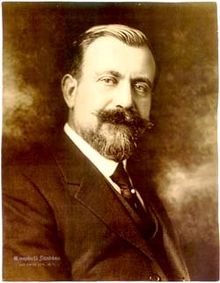Albert Capellani
Albert Capellani | |
|---|---|
 | |
| Born | 23 August 1874 Paris, France |
| Died | 26 September 1931 (aged 57) Paris, France |
| Occupation(s) | Film director, screenwriter |
| Years active | 1904–1922 |
Albert Capellani (23 August 1874 – 26 September 1931) was a French film director and screenwriter of the silent era. He directed films between 1905 and 1922.[1] One of his brothers was the actor-sculptor Paul Capellani,[2] and another, film director Roger Capellani.
Biography
Albert Capellani born in Paris in 1874. His father was a banker, and Capellani worked as a bank employee in his early years.
He continued to work as an actor and director until he received a job offer from the
He often drew upon his theatrical background to cast stage actor colleagues for his films, such as Henry Krauss, who appeared as Quasimodo in his The Hunchback of Notre Dame (1911) and as Jean Valjean in his Les Misérables (1912).[6] Les Misérables also gave the actress Mistinguett her first important screen role.[2]
His films cover many genres, including
In 1914 he served in the French army as an officer but was wounded in at the battle of Soissons near Champaigne First Battle of Champagne. He was released from duty but because of the war was unable to direct films in France.[citation needed]
In 1915, he moved to the United States and worked for the film studios
Capellani returned to France in 1923, where he floated several new film projects but was unable to bring any to fruition.[2] He died of diabetes in 1931.[5]
Selected filmography
- The Bell Ringer's Daughter (1906)
- Aladdin and His Wonder Lamp (1906)
- L'Arlésienne (1908)
- The Hunchback of Notre Dame (1911)
- Marie Tudor (1912)
- De Afwezige(1913)
- Germinal (1913)
- The Face in the Moonlight (1915)
- Camille (1915)
- The Foolish Virgin (1916)
- La Bohème (1916)
- The Common Law (1916)
- The Easiest Way (1917)
- Patrie (1917)
- Daybreak (1918)
- Eye for Eye(1918)
- The House of Mirth (1918)
- Out of the Fog (1919)
- The Red Lantern (1919)
- The Virtuous Model (1919)
- The Parisian Tigress (1919)
- The Love Cheat (1919)
- In Walked Mary (1920)
- Quatre-vingt-treize (1920)
- The Inside of the Cup (1921)
- The Wild Goose (1921)
- Sisters (1922)
- The Young Diana (1922)
References
- ^ The Internet Movie Database / Albert Capellani [unreliable source?]
- ^ ISBN 9780810869394
- ^ "Albert Capellani". en.notrecinema.com. Archived from the original on 25 June 2021. Retrieved 24 June 2021.
- OCLC 843382673.
- ^ a b c d e f Azoury, Philippe (2013), "Albert Capellani", Catalogue des restaurations et tirages, Cinémathèque française, retrieved 12 November 2014
- ^ a b c d e f Thompson, Kristin (24 November 2012), "Capellani ritrovato", David Bordwell's Website on Cinema, archived from the original on 13 November 2014, retrieved 12 November 2014
External links
- Albert Capellani at IMDb
